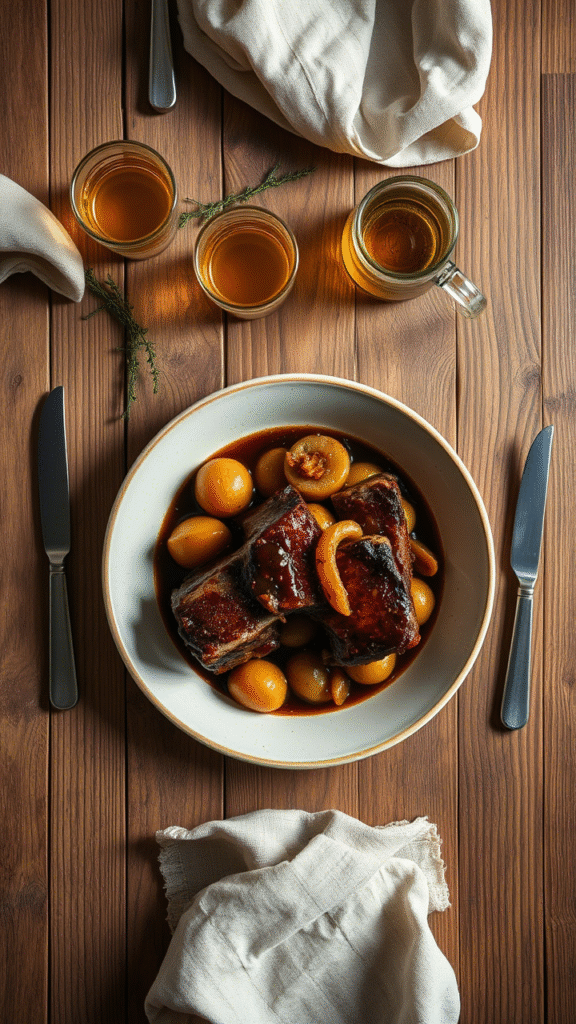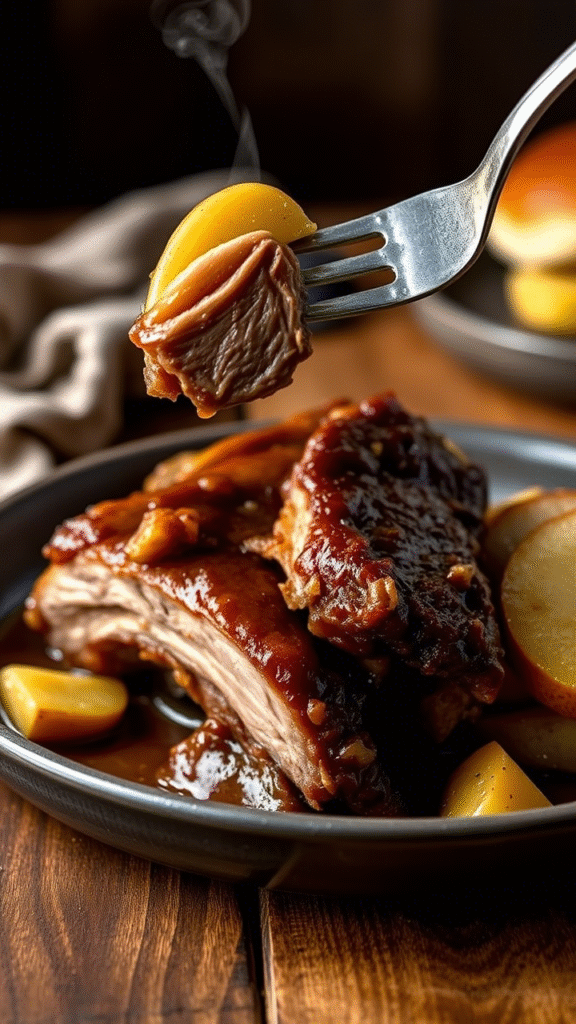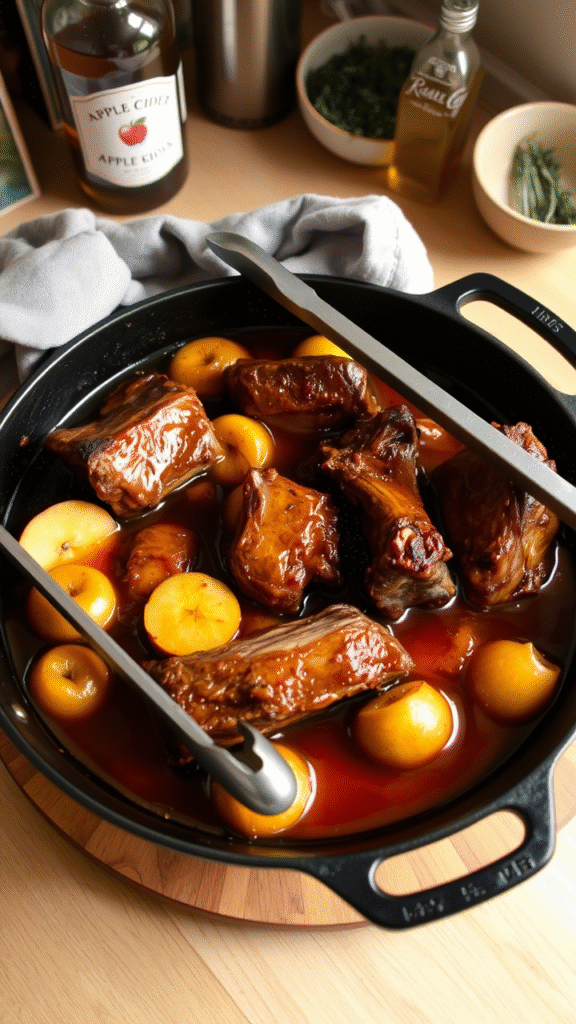Ever had ribs so tender they fall off the bone before you even lift the fork? That’s the kind of magic you get with apple cider braised pork ribs. Imagine the cozy sweetness of apple cider mingling with smoky pork, transforming simple ribs into a dish that sings with layers of flavor. It’s not just another BBQ recipe—this one’s a soul hug in a pan, with a twist of fall’s favorite fruit.
Apple cider braising isn’t just a cooking method; it’s a culinary conversation between pork and apple, where acidity and sweetness coax the meat into melting softness. This technique takes ribs beyond grilling or smoking, delivering juicy, fall-apart tenderness with a glossy, sticky glaze that’s a balance of sweet and savory. It’s special because it’s rooted in a smart, slow-cook approach that lets the cider’s natural sugars caramelize while tenderizing the pork gently. The end result? Ribs that burst with flavor, a little bit tangy, a little bit sweet, and entirely unforgettable.
Ingredients & Substitutions

Here’s what you’ll need, mostly stuff you might already have, with some clever swaps for picky eaters or dietary needs:
- 2 racks of pork ribs (baby back or St. Louis style)
- 2 cups apple cider (fresh pressed if possible)
- 1 large onion, thinly sliced
- 4 cloves garlic, minced
- 1/4 cup apple cider vinegar
- 1/4 cup brown sugar (dark or light depending on sweetness level)
- 2 tbsp Dijon mustard
- 1 tbsp smoked paprika
- 1 tsp ground black pepper
- 1 tsp kosher salt
- 1/2 tsp cayenne pepper (optional, for heat)
- Fresh thyme sprigs (or 1 tsp dried thyme)
- 2 tbsp olive oil or rendered pork fat
Substitutions:
If fresh apple cider’s hard to get, grab the best-quality pasteurized apple juice, but steer clear of the sweetened stuff—that’s cheating the acidity balance. For a vinegar swap, white wine vinegar or even balsamic (though it adds deeper sweetness) work. Got a nut allergy? Use avocado oil instead of olive oil. And if you’re going dairy-free but want creaminess in a side, skip the butter potatoes, and opt for a silky parsnip purée instead.
Ingredient Insights:
Fresh thyme offers that bright, earthy aroma that dried herbs often lack, so if you’re serious about flavor, fresh is the way. Brown sugar adds molasses richness that plain white sugar just can’t mimic. And smoked paprika? It’s the secret smoky whisper that keeps the ribs from feeling one-dimensional.
Step-by-Step Instructions

1. Prep the ribs:
Remove the thin membrane from the back of the ribs. It’s often overlooked but trust me, it’s key. Leaving it on makes ribs tougher and less absorbent. Score the surface lightly to help the flavors soak in.
2. Season the ribs:
Rub salt, pepper, smoked paprika, and cayenne evenly. Don’t be shy here — a good seasoning base is the backbone of deep flavor.
3. Sear for color:
Heat olive oil in a heavy-bottomed Dutch oven over medium-high. Brown the ribs on both sides till golden. This step locks in juices and adds caramelized notes. Don’t crowd the pan—work in batches if needed.
4. Build the braise:
Remove ribs, then toss in onions and garlic to soften and sweat for 3-5 minutes. Deglaze with apple cider vinegar, scraping the browned bits off the pan — that’s where flavor lives.
5. Add liquids and aromatics:
Pour in the apple cider, stir in the brown sugar and Dijon mustard. Add thyme sprigs. Nestle ribs back into the pot, meat side down.
6. Slow braise:
Bring liquid to a simmer, then cover and lower heat to maintain a gentle bubble. Cook for 2.5 to 3 hours. Patience here pays off—avoid boiling, or the meat will dry out.
7. Finish with glaze:
Once tender, remove ribs, set oven to broil. Reduce the braising liquid to a syrupy glaze on high heat, basting ribs generously. Broil ribs 3-5 mins for caramelized edges, watching closely to avoid burning.
Variations:
For a spicy kick, toss in extra cayenne or a chipotle pepper in adobo. Want smoky depth? Add a splash of liquid smoke or smoked sea salt.
Common mistakes:
Skipping the membrane or rushing the braise leads to tough ribs. Boiling the braise instead of simmering will dry out meat. Also, don’t skip searing—it’s non-negotiable for that rich color and taste.
Cooking Techniques & Science
Why braise? It’s a classic slow-moist-heat method ideal for tough cuts like pork ribs. The collagen in ribs breaks down during braising, turning into gelatin, which makes the meat luscious and moist. Using apple cider as the braising liquid adds acid, which helps tenderize proteins faster.
Searing before braising creates the Maillard reaction—complex flavor molecules form at high heat, enriching the taste. When you deglaze the pan with vinegar and cider, you’re capturing those flavorful browned bits, known as fond, making your braise liquid the heart of your dish.
A Dutch oven or heavy pot is your best friend here; its thick walls hold steady heat and distribute it evenly. This prevents hot spots and ensures ribs cook uniformly.
The reduction step at the end concentrates sugars and flavors into a sticky glaze, enhancing texture contrast between soft meat and caramelized crust. It’s the ultimate balance of science and art.
Serving & Pairing Suggestions

Plate your ribs on a rustic wooden board or a warm ceramic plate. Drizzle the sticky apple cider glaze over the ribs, letting it pool slightly. Scatter fresh thyme leaves or a sprinkle of flaky sea salt on top for that professional finish.
Sides? Think creamy mashed potatoes or a bright apple slaw with fennel and radish to echo the cider notes. Roasted root veggies, especially carrots glazed in honey and thyme, complement the rich pork.
For drinks, a crisp dry cider or a medium-bodied white wine like a Viognier works wonders. For beer lovers, a malty amber ale balances sweetness and cuts through fat beautifully.
Conclusion
Apple cider braised pork ribs deliver on tenderness, depth, and a complex flavor profile that’s both comforting and sophisticated. The interplay of sweet apple cider, tangy vinegar, and smoky spices is what sets this recipe apart from your standard rib prep. Braising is where the magic happens—slow heat, gentle bubbling, and patient hands turning tough ribs into a melt-in-your-mouth delight.
Remember, it’s all about layering flavors: from seasoning and searing to the braise and final glaze. Don’t rush any step. Treat the ribs with respect and time, and you’ll be rewarded with a show-stopping dish. Experiment with heat and herbs to find your signature spin.
FAQs
Q: Can I use pork spare ribs instead of baby backs?
A: Absolutely. Spare ribs have more fat and connective tissue, which means longer braising might be needed—aim for 3-3.5 hours for perfect tenderness.
Q: What if I don’t have apple cider vinegar?
A: White wine vinegar is a good substitute, or you can mix lemon juice with a pinch of sugar to mimic the acidity and sweetness.
Q: Can I make this in a slow cooker?
A: Yes, but skip searing first for best results. Cook on low for 6-8 hours. Finish under the broiler to caramelize the glaze.
Q: How do I store leftovers?
A: Refrigerate in an airtight container for up to 3 days. Reheat gently in a covered pan with a splash of cider or broth to keep moist.
Q: Can this recipe be made gluten-free?
A: Totally. Just double-check your mustard and paprika for any hidden gluten. Most basic spices and apple cider are naturally gluten-free.

Food lover, recipe creator & the heart behind NoshCrafters.com. Olivia shares mouthwatering, easy-to-make dishes that turn everyday meals into unforgettable bites. When she’s not experimenting in the kitchen, she’s busy plating up inspiration for home cooks everywhere.